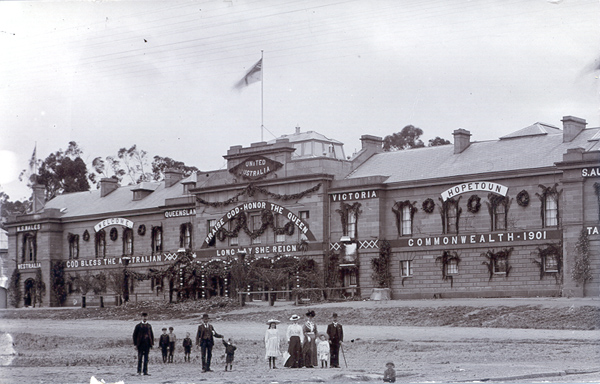 |
 |
|
Federal Movement
The Federal Movement in Tasmania was essentially a politicians' rather than a people's movement. Tasmanian interest in Australian federation dates back to the 1850s when self-government was achieved. In 1857 the Tasmanian government hopefully appointed delegates to an intercolonial conference on federation proposed by Victoria, but it was never held. With Victoria's discovery of gold and adoption of a protectionist policy, Tasmania was placed at a severe economic disadvantage. When New South Wales suggested a Federal Council, the Tasmanian Premier, WR Giblin, strongly supported the idea. The Federal Council (1885–99) played little part in the federal movement because New South Wales never joined. The real federal movement got under way after Parkes' famous Tenterfield speech in 1889. Inspired by defence fears, Parkes called for a National Convention to draft a constitution. The Federal Convention began in Sydney in 1891. Tasmanian delegates included AI Clark, who had prepared a draft constitution of his own, largely based on the American model. Of Clark's 96 sections, all but eight found their way into the draft bill, and only ten failed to find a recognisable counterpart in the Australian constitution. Clark was a man ahead of his time. While others saw federation as a customs union or a 'brighter jewel in the British crown', or both, Clark was speaking of Australian independence: 'We are proud to have sprung from the same race as the inhabitants of the British Isles. I believe, however, that it is our destiny to produce a different type of manhood from that which exists in those Islands. It is political autonomy we are now asking for Australia as a whole'. Clark introduced a Bill in the Tasmanian parliament for an elected Tasmanian Convention to consider the draft constitution. The Bill failed in the Legislative Council, and in 1891 the Mercury declared that federation was dead. With the onset of economic depression in the 1890s each colony turned in on itself, adopting its own remedies. George Reid, Premier of New South Wales, was strongly influenced by a popular movement in favour of federation. He suggested a Premiers' Conference which was held in Hobart in 1895. The premiers agreed that a convention be held with ten elected representatives from each colony. It would frame a federal constitution to be submitted to the electors for a direct vote. The Convention met successively in Adelaide, Sydney and Melbourne. Braddon, the Tasmanian Premier, persuaded it to adopt his proposal that one quarter of the revenue from customs and excise go to the commonwealth and three quarters to the states. The 'Braddon Blot' was attacked by New South Wales, who feared that the poorer states might become pensioners on the commonwealth. In 1898 Federal Leagues were formed in Launceston and Hobart. Braddon and his parliamentary colleagues were active in rousing public support. However Clark was virtually silent, concerned about forecasts of dire financial problems. The new constitution, based on the draft of 1891, was put to referendum in 1898. Although gaining majorities (81 percent in Tasmania), it failed to gain the required number of 'Yes' votes in New South Wales. The premiers met in 1899 and agreed that the Braddon clause be limited to ten years' operation, that the federal capital be in New South Wales, and that an absolute majority of members of both houses of the Commonwealth Parliament should settle disputes between the houses. At the second referendum (1899) New South Wales easily passed the required minimum affirmative vote. In Tasmania the second referendum achieved an affirmative vote of 94 percent – the highest in the Australian colonies. The Commonwealth Bill was approved by the imperial parliament. The Tasmanian vote was carried on a high tide of nationalism and economic attraction, but deep disillusionment followed, as the financial arrangements did not work at all well. A Commonwealth Royal Commission in 1910 recommended commonwealth assistance as imperative. Tasmania became the first state to seek financial assistance from the commonwealth under Section 96 of the Constitution. Further reading: J Craig, 'Tasmania and the federal Movement', THRAPP 22/1, 1975; M Roe, The state of Tasmania, Hobart, 2001. John Craig |
Copyright 2006, Centre for Tasmanian Historical Studies |
